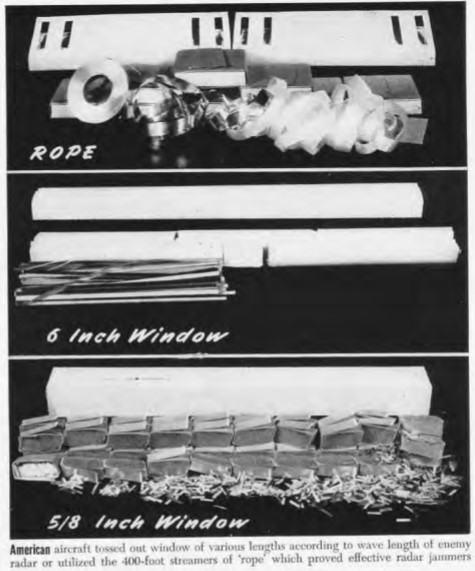One of the most difficult issues in researching & writing about electronic warfare in WW2’s Pacific Theater is it’s systematic exclusion from the USN’s official histories. This exclusion was as systematic was it was intentional.
1/
1/
The war diaries of the US Navy are both digitized and available on the Fold3.com service.
A simple search on the radar decoy code name “Window” in the WW2 War Diaries gets thousands of hits.
2/
fold3.com
A simple search on the radar decoy code name “Window” in the WW2 War Diaries gets thousands of hits.
2/
fold3.com
Window was one of the names for radar dipole decoys dropped from A/C, rockets, bombs and artillery.
The Japanese were both technically skilled and increasingly proficient in its use by 1945.
And, like those thousands of Fold3.com war diary hits, their efforts
3/


The Japanese were both technically skilled and increasingly proficient in its use by 1945.
And, like those thousands of Fold3.com war diary hits, their efforts
3/



...using window didn't make USN WW2 institutional history.
My trail of Japanese window use started with a spread sheet from MacArthur’s Sec. 22 files that detailed 53 locations and 54 specific instances of Japanese window use.
These occurred between 31 Aug. 1943 & Jan. 1945. 4/
My trail of Japanese window use started with a spread sheet from MacArthur’s Sec. 22 files that detailed 53 locations and 54 specific instances of Japanese window use.
These occurred between 31 Aug. 1943 & Jan. 1945. 4/

The first window use against a SWPA radar was at Hammond Island, Queenland, Australia.
This Royal Australian Air Force (RAAF) radar site worked with No. 3 Fighter Sector (3FS) in covering the Torres Strait facing New Guinea, which operated between 1942 and 1943.
5/


This Royal Australian Air Force (RAAF) radar site worked with No. 3 Fighter Sector (3FS) in covering the Torres Strait facing New Guinea, which operated between 1942 and 1943.
5/



The last Section 22 tactical window reference was from Jan 1945 to a cache of window captured from a belly landed Jill bomber found in Caguray River Bed (Philippines).
7/
7/

Lt. Commander Sudo Hajime’s gima-shi “deceiving paper" was 1st used a Guadalcanal in May 1943.
In addition to pre-dating the Hammond Island drop, this was well before the Operation Gomora firebombing raid on Hamburg.
8/
quora.com/Did-the-Japane…
In addition to pre-dating the Hammond Island drop, this was well before the Operation Gomora firebombing raid on Hamburg.
8/
quora.com/Did-the-Japane…

The USMC 10th Defense Battalion March 1944 war diary while on Kwajalein shows successful Japanese air raids on 8 March 1944 were aided by the use of gima-shi radar countermeasures vs it's 2-meter band SCR-268 GFC radars.
9/
en.wikipedia.org/wiki/10th_Anti…
9/
en.wikipedia.org/wiki/10th_Anti…
SSgt Jacob Marty from USMC Air Warning Squadron-1 was killed in that March 1944 attack.
Subsequently the 10th's SCR-268's were replaced by US Army SCR-584 to support 90mm gun while USN Mark 20 radars were adapted to ground based searchlight work.
10/
en.wikipedia.org/wiki/Marine_Ai…
Subsequently the 10th's SCR-268's were replaced by US Army SCR-584 to support 90mm gun while USN Mark 20 radars were adapted to ground based searchlight work.
10/
en.wikipedia.org/wiki/Marine_Ai…

The Digital collection of the WW2 National Museum has a nice interview with Thomas Kolesa, a US Marine Mk 20 radar operator at Okinawa.
11/
ww2online.org/view/thomas-ko…
11/
ww2online.org/view/thomas-ko…
Thomas Kolesa modified his Mk 20 at Okinawa to extend it's range from 25,000 to 30,000 yards when the Japanese figured out it's range based on when their planes were being illuminated.
/12

/12


Returning to 1944, the 1st US Navy mention of a warship seeing Japanese window in FOLD3.com was 12 Feb 1944 at ~0200 in the morning by USS Mustin (DD413).
She was escorting CVE's off Roi Island.
13/
She was escorting CVE's off Roi Island.
13/

Pretty much every USMC amphibious landing from Eniwetok to Okinawa saw Japanese use of window.
The USMC early warning teams attached to IIIMAC & US Army XXIVth Corps at Okinawa recorded 43 separate window drops the nights of 12-19 April 1945.
14/
The USMC early warning teams attached to IIIMAC & US Army XXIVth Corps at Okinawa recorded 43 separate window drops the nights of 12-19 April 1945.
14/

Yet how many naval histories of the Pacific War mention that even once?
There are a lot of history PhD's awaiting the ambitious willing to run this down.
/End
There are a lot of history PhD's awaiting the ambitious willing to run this down.
/End
@threadreaderapp unroll, please.
• • •
Missing some Tweet in this thread? You can try to
force a refresh









